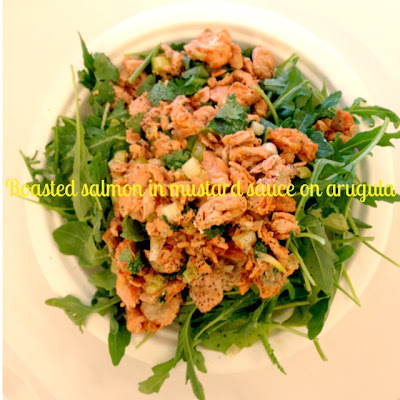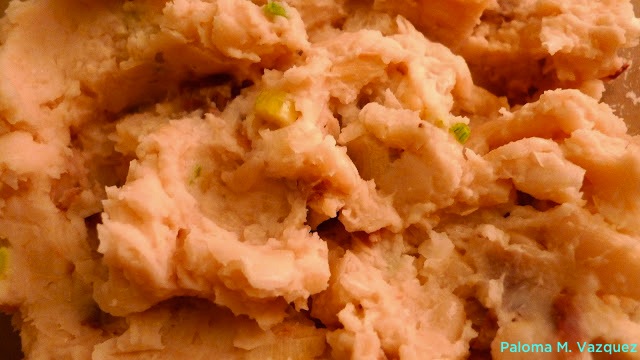I'll admit: turning on an oven or stove top in a small Manhattan kitchen on a sweltering summer night isn't high on the list of 'things to look forward to all day'. But I've learned that, when it comes to eating well, a bit of upfront preparation saves you more time later (and poor decisions made in the haze of starvation). So, on most Sunday nights, I spend about an hour and a half batch-cooking several meals for the first half of the week.
One of the questions I'm most often asked is how I find the time to cook every day (immediately followed by "and can you cook for me?"). The answer is that I don't necessarily 'cook' every day. I cook about 3-4 times a week, but I make sure that I cook enough to constitute several meals that will just need to be re-heated throughout the week. While I'd love the magic of impromptu meal planning most nights - discussing ideas, choosing from ingredients bought that weekend at the farmer's market, and cooking together on a weeknight with a glass of wine in hand - the reality is that most days, our lifestyles just don't allow for that leisure. Batch cooking and a bit of meal-planning ensures that I have multiple home-hooked, nutritious and CLEAN lunches/dinners for the week - with room for spontaneity.
So, I thought I'd show you how I minimize my cooking but plan my meals to cover me throughout the week - leaving some flexibility for spontaneity. The following meal plan may cover up to 2 people, and meals can be swapped around. Each 'batch' can easily be increased to accommodate your and your family's needs. While I don't have first-hand experience raising kids just yet, I suspect that batch cooking could also provide an effective strategy for families with children.
So let's get to it. Here's how I'm planning my meals this week:
Key Batches/Meals:
Sunday night batches:
1) Roasted salmon with green onions and mustard sauce (RS)
2) Kale sautéed with garlic and pecans (KG)
3)
Truffled cannelini bean mash (TC):
for this , you'll need to soak 1 cup dry beans per two people the night prior, or early that morning.
* Tip: make a large batch of the mustard sauce - double what you'll need for the salmon - and you'll have home-made salad dressing ready to go for the next day or two. Forget the bottled variety at the grocery store
For the salmon: Buy about two large filets
wild-caught salmon (don't risk Frankenfish with the farm-raised variety). Each filet will offer two individual servings. I ask for it de-skinned. Bring a large skillet (
sprayed with olive oil) to medium heat on your stove top, and add the filet/s of salmon. When it starts to look translucent, break it up loosely with a wooden spatula until you have bite-sized pieces. At this point, add about 3-4 stalks chopped green onions, and about two tablespoons mustard sauce. Go lightly - I like to taste the salmon, so the mustard sauce should be a mild complement, not a heavy sauce. You want to see far more pink than what you do yellow from the mustard. When the salmon is cooked to your liking, take it off the heat.
While the salmon was cooling and set aside, I was working on chopping up a large mound of kale into smaller pieces, and set it aside. I also peeled and chopped about 3 cloves of fresh garlic. I set aside a handful of pecans. After the salmon was placed in containers, refrigerated and my skillet washed (remember, my Manhattan kitchen is PINT SIZED), I got ready for batch no. 2:
For the kale: Heat the skillet to medium heat. Spray about 1 tablespoon (or less) of olive oil. Add kale one handful at a time, and cook until it all starts turning bright green (and wilting - they WILL shrink). Start adding in the chopped garlic and pecans, until both are toasted. Add salt and pepper to taste. Turn off the heat, set aside. Two down, one to go.
For the beans: Take a breather. Clean up the kitchen. And get ready for your final batch. While a large pot with your beans is boiling and cooking, chop about four green onions. To keep more ready for the week (and for your more spontaneous scrambled eggs), chop 4 more stalks and keep in a covered container in our fridge. Follow
these instructions for the bean mash, using the green onions. The anchovies are purely optional - it's summer and I crave lighter meals, so I left them out.
Wednesday night batches:
1)
Ground (grass-fed) beef with scallions and salsa verde (GB)
2)
Roasted curried cauliflower florets (CC): This is Summer Tomato's recipe - I adapt/play with it and how I season it - so can you
3)
Green lentil and green onion salad with cilantro (LC)
Stock Ingredients: These are things I have on hand for snacking, side dishes, or spontaneous meal preparation. Wherever possible, I chose organic. And ideally, source them from a farmer's market run on Saturdays (or Whole Foods):
- Arugula, or other greens
- Avocado
- Tomatoes
- Scallions or green onions
- Cilantro
- Lemons
- Blueberries (summertime only)
- Cherries (summertime only)
- Bananas
- Eggs
- Oats (whole - not the prepared, sweetened variety)
- Unsweetened almond milk
- Dry lentils
- Home-made vinaigrette, refrigerated (whisk olive oil, dijon mustard, white vinegar, lemon juice, salt and pepper to taste. Refrigerate. Beats anything out of a pre-packaged bottle)
The Meal Plan:
1) Monday:
Lunch: Roasted Salmon + organic baby arugula (or other greens)
Snack: Sautéed Kale with Pecans
Dinner: Organic tomato and half a ripe avocado, chopped and drizzled with olive oil, topped with fresh cilantro. That or Truffled Cannelini bean mash + a side of greens drizzled with the mustard vinaigrette you saved from last night.
2) Tuesday:
Lunch: Roasted Salmon + bed of organic greens
Snack: Sautéed Kale with Pecans (or fruit)
Dinner: Cannelini bean mash + greens, or I'll be spontaneous. Scramble two eggs with fresh chopped scallions, and a side of a tomato drizzled with olive oil and cilantro.
* Tip 1: You can make the tomato salad fresh, or double up the night before and have this ready - though it won't be as 'crisp' and chopping and serving fresh.
3) Wednesday:
Lunch: Truffled Cannelini + bed of organic greens
Snack: Fruit (banana, cherries, blueberries - your pick)
Dinner: Wednesday night, I'll cook the Ground Beef (GB) and the Curried Cauliflower (CC), and the Lentil, Green Onion and Cilantro Salad (LC). I'll have some of the ground beef and cauliflower for dinner, but keep the rest for Thursday and Friday.
4) Thursday:
Lunch: Ground Beef + Curried Cauliflower
Snack: Fruit (banana, cherries, blueberries - your pick)
Dinner: Lentil Cilantro Salad served on a bed of greens. Might whisk up more of my mustard vinaigrette on the spot, Seriously, this will take less than 5 minutes. Keep the leftovers covered for another day (just re-stir or re-whisk).
5) Friday:
Lunch: Lentil Cilantro salad on a bed of greens
Snack: May walk to a store to pick something up - fresh fruit or yogurt
Dinner: Will have dinner out
So, in short: I cooked a few meals in one shot twice during the week, but it'll offer lunch and dinner for several days. I have fresh vegetables on hand to quickly cut up and serve as a salad, and quickly whisk my own home-made mustard vinaigrette to top raw vegetables with (though you can stick to olive oil + vinegar, if that's your thing). I snack on fresh fruit, yogurt or a salad. I bring fresh food to the office (like the bag of greens and fruit) and I keep it in the fridge for immediate access, and even have a small jar of olive oil and my own dijon mustard for dressing. And I allow room for spontaneity. When dinner pops up during the week, great - I'll keep what I had at home for lunch the next day.
One last note: you'll notice that breakfast was left off this list. I truly believe there's no excuse to skip breakfast. If you wake up just 10 minutes earlier, I promise you can get it together to make my crazy quick
almond milk and chia seed oatmeal, which takes less than 5 minutes to cook on the stove top. You can even just grab a half avocado + banana, or some other fruits and almond milk, or yogurt and fruit and be done with it - no cooking required. But just get it together and make this meal count - it'll keep you satiated and energized until lunchtime.
Thoughts, questions? Till next time!
- Paloma









.JPG)

.JPG)
.JPG)




.JPG)

.JPG)













